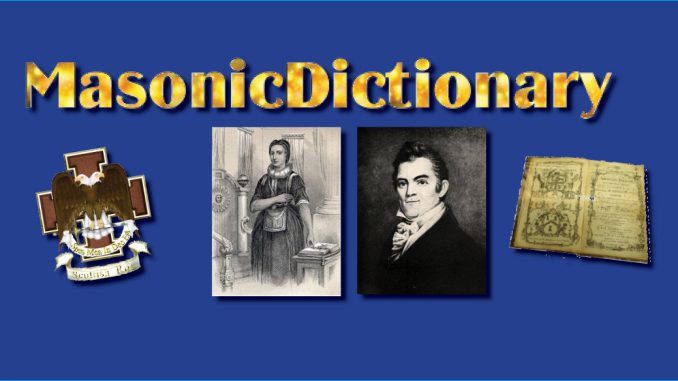
By Bro. H. A. Kingsbury, Massachusetts
Kingsbury, Harold A.; born, Westfield, Mass., August 27, 1882; graduate in Chemical Engineering, Massachusetts Institute of Technology, Boston, Mass., 1907; graduate in Law, National University, Washington, D. C., 1910; graduate in Patent Law, George Washington University, Washington, D. C., 1911; Member of Bar of District of Columbia; Member of Bar of Supreme Court of United States; Assistant Examiner U.S. Patent Office, 1908-1912; at present, Assistant Patent Counsel, The New Departure Mfg. Co., Bristol, Connecticut; Washington Centennial Lodge No. 14, Washington, D. C.; Mount Vernon Chapter No. 3, Washington, D. C.; Scottish Rite Bodies, 4d to 18d, Springfield, Mass.; 19d to 32d, Massachusetts Consistory, Boston, Mass.
IN the case of many of the symbols used in Masonry it almost seems as though the ritual writers must have followed the rule, “The importance to be given a symbol in the ritual should be inversely proportional to the real importance of that symbol.” Particularly does this rule seem to have been applied to the case of one of the Jewels of the Lodge–the Perfect Ashlar or Perfect stone Cube. For this symbol, though casually dismissed with but two or three brief sentences in the monitorial instructions, is, in reality, of very considerable importance and interest and deserving of the careful attention of the Mason.
The Perfect Ashlar is one of a group of three Jewels. Thus the symbol calls the Mason’s attention to one more of the many (not less than twenty) references, in Craft Masonry, to the number Three – the most significant of all the numbers (unless it be Seven) held in veneration in nearly every ancient system of religious philosophy, and even having, in some of those systems, notably that of Plato, the importance of a symbol of Deity.
Stone, the material of the Perfect Ashlar, was considered of great importance in many of the ancient religions and, indeed, in some was worshiped. Stone worship existed among the early American races. There is good reason for believing that the Peruvians worshiped stones, as the protectors of their crops. The Greeks originally used unhewn stones to represent their deities. The Thebans represented the god Bacchus by a stone. In the Kaaba at Mecca is a stone, Hajar al Aswad, which was worshiped by the ancient Arabians and which present-day Mohammedans regard with veneration. The Druids represented their gods by stones.
Stone is so evidently the symbol of Permanency, Faith and Trust that it seems almost unnecessary to cite examples here. But any one familiar with his New Testament will recall the incident of the giving of the name Cephas, or Peter, meaning a stone, to simon, who stood for the permanency, faith and truth of the Early Christian Church, and will recall that Christ said, “Thou art Peter and on this rock I will build my Church.”
The cubical form of-the Perfect Ashlar serves to further identify it as the symbol of Permanency, Faith and Truth as the Cube, from the time of the Ancients has had this significance. We have an example of it in Revelations (XXI, 16) where the New Jerusalem is described as having its length, breadth and thickness equal, each to the other, giving, of course, a cubical form to the city.
The fact that Masonry uses a hewn, rather than an unhewn stone, for symbolizing Truth, furnishes an interesting example of the ways in which the introduction of (comparatively) self-evident conceptions derived from Operative Masonry has worked, in some instances, curious changes in the more abstruse symbolistic systems which Masonry has, apparently, inherited from the Hebrews and the Egyptians. That is, in the Masonic system, following at this point suggestions from Operative Masonry, the hewn and perfect condition of the Perfect Ashlar is understood to emphasize and make yet stronger the symbol’s reference to Truth, whereas in the symbolistic systems of the Hebrews and the Egyptians a rough, unhewn cubical stone was considered to symbolize Truth and a perfect, hewn stone was understood to symbolize Falsehood.
However interesting and important the various other symbolic significances of the Cube may be, the symbolic suggestion that perhaps most concerns the Mason of today, and particularly the American Mason of today, is this:–The Cube is the symbol of the state and it is placed in the Masonic Lodge to constantly remind the Mason, of the State, or political structure, of which he forms a part, and to recall him to those duties which he, a citizen, owes to that State.
If one views a cube with his eyes slightly above the top of it, and opposite one of its vertical edges, he will find that, as indicated in the figure, there are three faces visible, and three invisible, to him. The three visible faces symbolize the three departments of the State, the Legislative, which makes the laws, the Judicial which interprets them, and the Executive which executes them. The three invisible faces symbolize the invisible soul of the State, Liberty, Equality and Fraternity. As these three invisible faces are necessary to complete and make stable the Cube so are Liberty, Equality and Fraternity necessary to complete and make stable the State.
The Perfect Ashlar, in its character of a symbol of the State, represents an ideal to be striven for–the perfect State has not yet been finally developed. But, upon his first entrance into Masonry, the Mason is presented with Working Tools with which to shape and to gauge his work–the Gavel, symbolizing Force, and the Gauge, symbolizing Rule or Law. And the Perfect Ashlar reminds the Mason that his entered apprentice’s Working Tools are given him to use and that it is for him, a citizen, to apply them, using Force, properly held in restraint by Rule or Law, to, so far as in him lies, make his ashlar a Perfect Ashlar and his state a perfect State.
